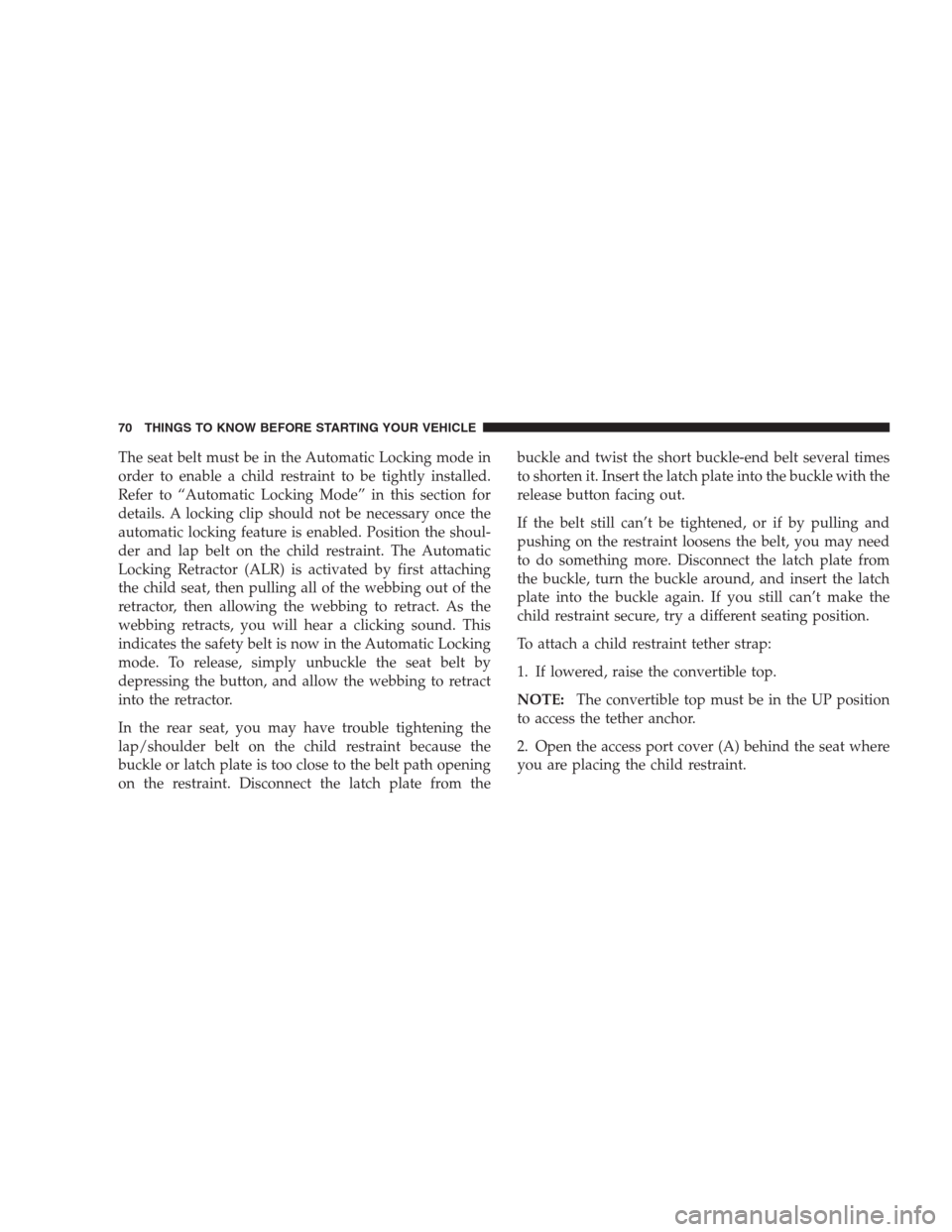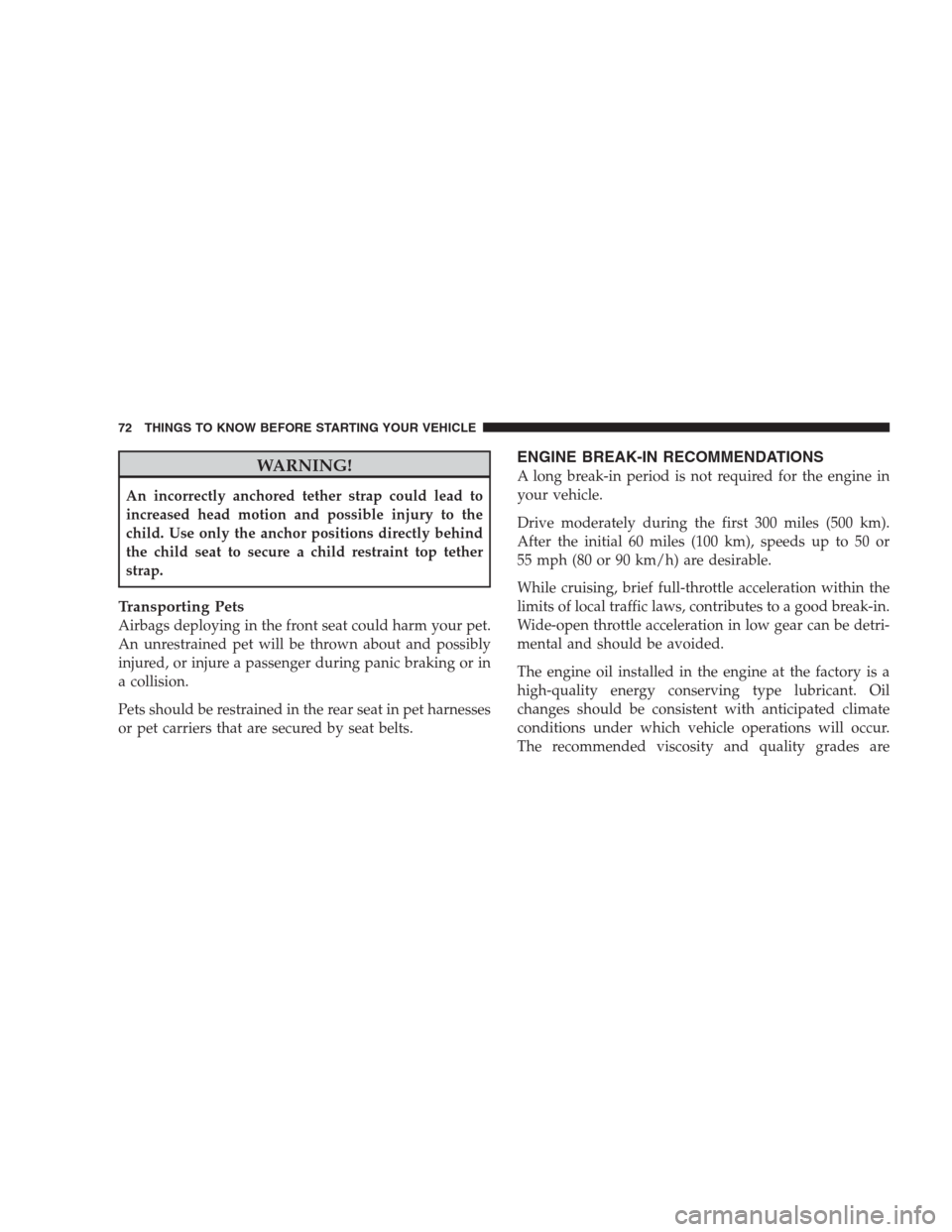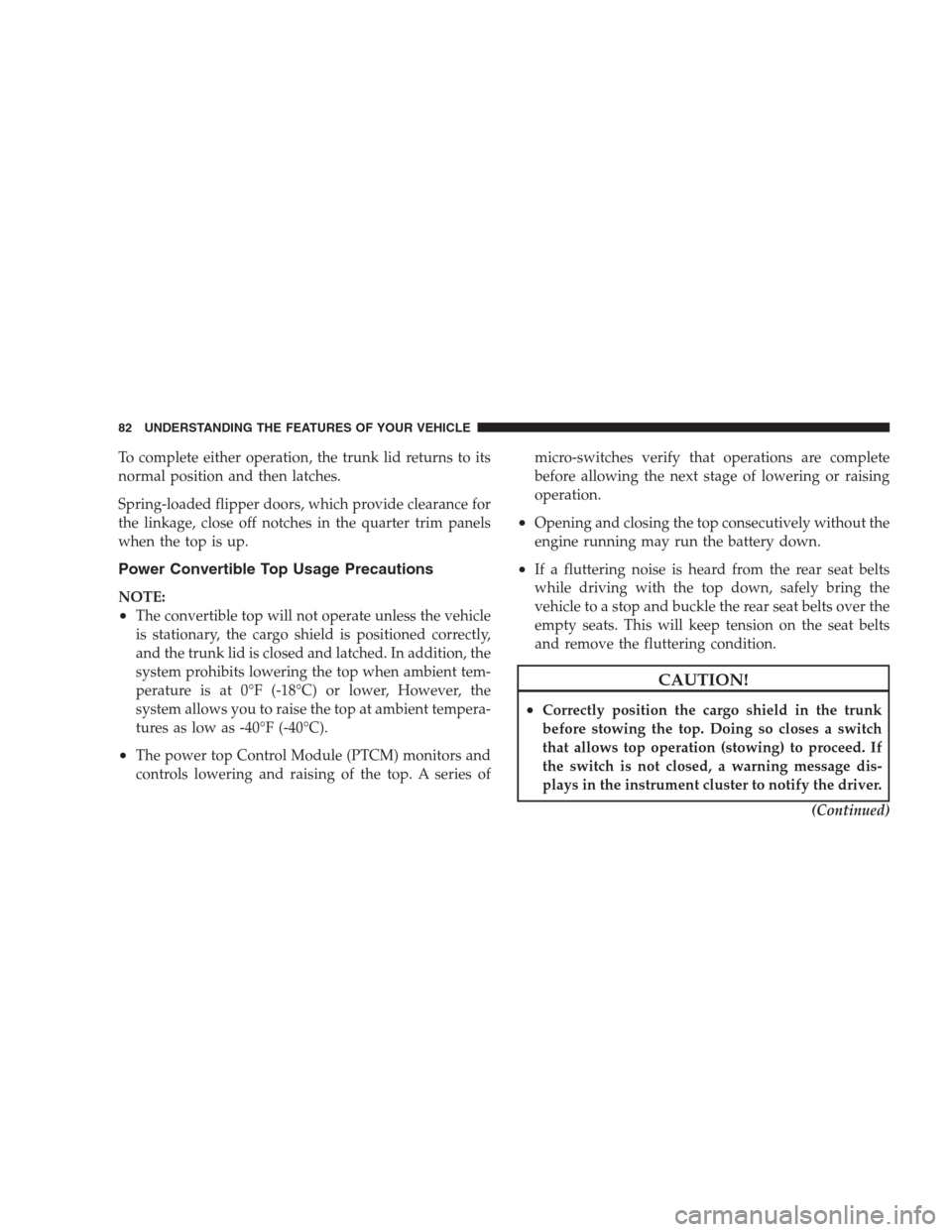Page 64 of 475

•Airbag deployment level (if applicable)
•Impact acceleration and angle
•Seat belt status
•Brake status (service and parking brakes)
•Accelerator status (including vehicle speed)
•Engine control status (including engine speed)
•Transaxle gear selection
•Cruise control status
•Traction/stability control status
•Tire Pressure Monitoring System status (if equipped)
Child Restraints
Everyone in your vehicle needs to be buckled up all the
time, including babies and children. Every state in the
United States and all Canadian provinces require thatsmall children ride in proper restraint systems. This is the
law, and you can be prosecuted for ignoring it.
Children 12 years and younger should ride properly
buckled up in a rear seat, if available. According to crash
statistics, children are safer when properly restrained in
the rear seats, rather than in the front.
WARNING!
In a collision, an unrestrained child, even a tiny baby,
can become a missile inside the vehicle. The force
required to hold even an infant on your lap could
become so great that you could not hold the child, no
matter how strong you are. The child and others
could be badly injured. Any child riding in your
vehicle should be in a proper restraint for the child’s
size.
62 THINGS TO KNOW BEFORE STARTING YOUR VEHICLE
Page 68 of 475

•All passenger seating positions contain automatic
locking retractors. However, any seat belt system will
loosen with time, so check the belt occasionally and
pull it tight if necessary.
•Buckle the child into the seat according to the child
restraint manufacturer’s directions.
CAUTION!
When your child restraint is not in use, secure it in
the vehicle with the seat belt or remove it from the
vehicle. Do not leave it loose in the vehicle. In a
sudden stop or collision, it could strike the occupants
or seatbacks and cause serious personal injury.
LATCH — Child Seat Anchorage System (Lower
Anchors and Tether for CHildren)
Your vehicle is equipped with the child restraint anchor-
age system called LATCH. The LATCH system providesfor the installation of the child restraint without using the
vehicle’s seat belts. The two rear seating positions have
lower anchorages that are capable of accommodating
LATCH-compatible child seats having flexible, webbing-
mounted lower attachments or fixed lower attachments.
Regardless of the specific type of lower attachment,
NEVERinstall LATCH-compatible child seats such that
two seats share a common lower anchorage. If you are
installing LATCH-compatible child restraints in adjacent
rear seating positions, you can use the LATCH anchors or
the vehicle’s seat belts. If your child restraints are not
LATCH-compatible, you can only install the child re-
straints using the vehicle’s seat belts. For typical instal-
lation instructions, refer to “Installing the LATCH-
Compatible Child Restraint System”.
Rear Seat LATCH Anchors
Child restraints systems having attachments designed to
connect to the lower anchorages are now available. Child
restraints having tether straps and hooks for connection
66 THINGS TO KNOW BEFORE STARTING YOUR VEHICLE
Page 72 of 475

The seat belt must be in the Automatic Locking mode in
order to enable a child restraint to be tightly installed.
Refer to “Automatic Locking Mode” in this section for
details. A locking clip should not be necessary once the
automatic locking feature is enabled. Position the shoul-
der and lap belt on the child restraint. The Automatic
Locking Retractor (ALR) is activated by first attaching
the child seat, then pulling all of the webbing out of the
retractor, then allowing the webbing to retract. As the
webbing retracts, you will hear a clicking sound. This
indicates the safety belt is now in the Automatic Locking
mode. To release, simply unbuckle the seat belt by
depressing the button, and allow the webbing to retract
into the retractor.
In the rear seat, you may have trouble tightening the
lap/shoulder belt on the child restraint because the
buckle or latch plate is too close to the belt path opening
on the restraint. Disconnect the latch plate from thebuckle and twist the short buckle-end belt several times
to shorten it. Insert the latch plate into the buckle with the
release button facing out.
If the belt still can’t be tightened, or if by pulling and
pushing on the restraint loosens the belt, you may need
to do something more. Disconnect the latch plate from
the buckle, turn the buckle around, and insert the latch
plate into the buckle again. If you still can’t make the
child restraint secure, try a different seating position.
To attach a child restraint tether strap:
1. If lowered, raise the convertible top.
NOTE:The convertible top must be in the UP position
to access the tether anchor.
2. Open the access port cover (A) behind the seat where
you are placing the child restraint.
70 THINGS TO KNOW BEFORE STARTING YOUR VEHICLE
Page 74 of 475

WARNING!
An incorrectly anchored tether strap could lead to
increased head motion and possible injury to the
child. Use only the anchor positions directly behind
the child seat to secure a child restraint top tether
strap.
Transporting Pets
Airbags deploying in the front seat could harm your pet.
An unrestrained pet will be thrown about and possibly
injured, or injure a passenger during panic braking or in
a collision.
Pets should be restrained in the rear seat in pet harnesses
or pet carriers that are secured by seat belts.
ENGINE BREAK-IN RECOMMENDATIONS
A long break-in period is not required for the engine in
your vehicle.
Drive moderately during the first 300 miles (500 km).
After the initial 60 miles (100 km), speeds up to 50 or
55 mph (80 or 90 km/h) are desirable.
While cruising, brief full-throttle acceleration within the
limits of local traffic laws, contributes to a good break-in.
Wide-open throttle acceleration in low gear can be detri-
mental and should be avoided.
The engine oil installed in the engine at the factory is a
high-quality energy conserving type lubricant. Oil
changes should be consistent with anticipated climate
conditions under which vehicle operations will occur.
The recommended viscosity and quality grades are
72 THINGS TO KNOW BEFORE STARTING YOUR VEHICLE
Page 82 of 475
▫Gate Operator/Canadian Programming.... 162
▫Security........................... 163
▫Troubleshooting Tips.................. 163
▫General Information.................. 164
�Electrical Power Outlets................. 164
�Cigar Lighter And Ash Receiver —
If Equipped.......................... 167
�Cupholders.......................... 167
▫Front Seat Cupholder................. 167▫Heated Or Cooled Cupholder —
If Equipped........................ 168
▫Rear Seat Cupholders................. 169
�Console Features...................... 170
▫Storage........................... 170
▫Sliding Armrest — If Equipped.......... 172
�Rear Window Features.................. 173
▫Rear Window Defroster — If Equipped..... 173
80 UNDERSTANDING THE FEATURES OF YOUR VEHICLE
Page 84 of 475

To complete either operation, the trunk lid returns to its
normal position and then latches.
Spring-loaded flipper doors, which provide clearance for
the linkage, close off notches in the quarter trim panels
when the top is up.
Power Convertible Top Usage Precautions
NOTE:
•The convertible top will not operate unless the vehicle
is stationary, the cargo shield is positioned correctly,
and the trunk lid is closed and latched. In addition, the
system prohibits lowering the top when ambient tem-
perature is at 0°F (-18°C) or lower, However, the
system allows you to raise the top at ambient tempera-
tures as low as -40°F (-40°C).
•The power top Control Module (PTCM) monitors and
controls lowering and raising of the top. A series ofmicro-switches verify that operations are complete
before allowing the next stage of lowering or raising
operation.
•Opening and closing the top consecutively without the
engine running may run the battery down.
•If a fluttering noise is heard from the rear seat belts
while driving with the top down, safely bring the
vehicle to a stop and buckle the rear seat belts over the
empty seats. This will keep tension on the seat belts
and remove the fluttering condition.
CAUTION!
•Correctly position the cargo shield in the trunk
before stowing the top. Doing so closes a switch
that allows top operation (stowing) to proceed. If
the switch is not closed, a warning message dis-
plays in the instrument cluster to notify the driver.
(Continued)
82 UNDERSTANDING THE FEATURES OF YOUR VEHICLE
Page 97 of 475
EVIC
Message�EVIC
Message
Display
Time�Odometer
Message
(< 5 mph
[8 km/h])
��Odometer
Message
Display
Time��Odometer
Message
(> 5 mph
[8 km/h])
��Odometer
Message
Display
Time��Chime Condition Operator
Action
Required
SECURE
CARGO
SHIELD9 Seconds SET
CARGO
SHIELDDisplay
Scrolls for 9
Seconds— — Single
ChimeThe Top
Fails to
Move When
Operating
the Power
Top ControlPosition the
Cargo
Shield in
the Trunk
to Allow
Top Opera-
tion
CONVERT-
IBLE TOP
IN OPERA-
TIONUntil Op-
eration is
CompleteTOP Until Op-
eration is
CompleteTOP Until Op-
eration is
CompleteSingle
ChimeThe System
Fails to
Complete
Operation of
Lowering or
Raising the
To pCycle
Power Top
Control
UNDERSTANDING THE FEATURES OF YOUR VEHICLE 95
3
Page 100 of 475

���The PTCM will lockout the power convertible top system if the vehicle charging system is malfunctioning,
or the battery is run down, or the hydraulic pump is overheating. In addition, the system prohibits lowering the
top when ambient temperature is at 0°F (-18°C) or lower and raising the top when ambient temperature is below
-40°F (-40°C).
•If you are trying to lower the top and ambient temperature is 0°F (-18°C) or lower, wait until the temperature
rises and the top is thawed and dry before operating the power top.
•If you are trying to raise the top and ambient temperature is below -40°F (-40°C), wait until the temperature
rises before operating the power top.
•If the vehicle charging system is malfunctioning, see your authorized dealer for service.
•If the battery is run down, have it recharged and tested at your authorized dealer.
•Hydraulic pump overheating can occur if you lower and raise the top consecutively (usually more than six or
seven times depending upon the ambient temperature). Wait at least five minutes before operating the power top
again.NOTE:If lockout occurs due to hydraulic pump overheating, the system will allow you to raise the top
without waiting five minutes. However, do so only if necessary.
98 UNDERSTANDING THE FEATURES OF YOUR VEHICLE